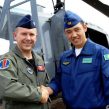
Kazakhstan Hosts Steppe Eagle 2012
Publication: Eurasia Daily Monitor Volume: 9 Issue: 164
By:

Kazakhstan is hosting the international peacekeeping exercise Steppe Eagle 2012, amidst growing speculation that the country plans to deploy a company of peacekeepers abroad. Astana ultimately resisted the West’s efforts to persuade the country to send peacekeepers to Afghanistan, but is now turning to consider less politically sensitive options (Interfax, September 6).
Steppe Eagle has been hosted annually since 2003, and began as a trilateral exercise joining the militaries of Kazakhstan, the United Kingdom and the United States, aimed at boosting the capabilities of Kazakhstan’s peacekeeping battalion (KAZBAT). Following Astana’s decision to send a small contingent of military engineers from KAZBAT to Iraq in 2003, the country stepped up its interest in strengthening such capabilities, and the training process became linked to its NATO Partnership for Peace (PfP) goals. At the same time, Astana attempted to expand its peacekeeping battalion into a full brigade (KAZBRIG). In 2008, during that year’s Steppe Eagle exercise and just prior to ending KAZBAT’s mission in Iraq, a NATO assessment team formally declared that KAZBAT had achieved a level of NATO interoperability. This was a milestone for Central Asia, and to date KAZBRIG is the only peacekeeping force in the region to attain such a level of interoperability with the Alliance (see EDM, September 12, 2008).
Steppe Eagle 2012 opened at the Iliisky training center in Almaty region on September 6, and will conclude on September 21. The exercise involves KAZBRIG and personnel from the Armed forces of the UK, the US and a Tajik Special Forces platoon, joined by observers from France, Germany, Italy, Kyrgyzstan, Lithuania, Switzerland and Ukraine. The bulk of the total number of participating personnel of around 1,500 are drawn from KAZBRIG, while the US sent approximately 150 servicemen from the Rangers, National Guard and Airborne units. Whereas, the UK was represented by 15 officers and soldiers.
During the opening ceremony on September 6, the first deputy head of the committee of the chiefs of staffs of Kazakhstan’s Defense Ministry, Lieutenant-General Nurlan Dzhulamanov, said, “Steppe Eagle is an exercise, which was and continues to remain a first-class multinational exercise. The exercise is aimed at improving the operative opportunities of combat readiness and capabilities to hold peacekeeping operations with the participation of international forces” (Interfax, September 6).
The training of KAZBRIG, provided mainly by the UK and the US since 2003, has concentrated on preparing the Kazakhstani Armed Forces to operationally deploy at least a company from KAZBRIG on an international peace support operation. Washington and London canvassed Astana heavily in the period of 2007–2011, pressuring Kazakhstan to send a company to participate in the International Security Assistance Force (ISAF) in Afghanistan. In June 2011, after Astana advocated sending a small number of officers from KAZBRIG to Afghanistan to participate at ISAF HQ, the Kazakhstani Senate blocked the deployment (Interfax, June 21, 2011).
KAZBRIG, however, is only a paper brigade at present, since the second battalion is partially formed, and the third battalion has no personnel; the mainstay of the force remains the 1st battalion KAZBAT. This often confuses experts and commentators, leading to the mistaken belief that KAZBAT and KAZBRIG are separate entities (see EDM, October 13, 2009). Within the structure itself there are continued problems linked to recruiting sufficient numbers of contract personnel and retaining these over a lengthy period, as well as concerning the procurement of standard weapons and equipment. Achieving full NATO interoperability for KAZBRIG remains a goal in Kazakhstan’s Individual Partnership Action Plan (IPAP).
There are signs that Astana is seriously considering sending part of KAZBRIG to participate in a peace support operation under a UN flag, possibly in Africa. The 2011 Military Doctrine commits the country to further develop its peacekeeping capabilities, and this is highlighted as the only area of cooperation with NATO—despite the existence of ongoing PfP programs in which Kazakhstan participates included in the country’s IPAP agreement (Interfax, September 5). Senior Kazakhstani officers told Jamestown that the defense ministry has also drawn up a list of possible UN deployments and arrived at seven feasible operations in which it may become involved. This will be submitted to the foreign ministry for further consideration. When the selection process is complete, it will fall on the parliament to authorize the deployment of KAZBRIG personnel abroad. It is less likely, therefore, that KAZBRIG will be deployed in NATO-led operations.
Astana and Washington are currently negotiating a new five-year bilateral cooperation plan to enter into force from 2013. Undoubtedly, the issue of a quid pro quo, meaning an actual foreign deployment of KAZBRIG elements, will be built into the plan and the subsequent training and defense cooperation. Steppe Eagle 2012 appears to be a small step in the direction of Kazakhstan becoming a fuller player in international peace support operations. However, it must balance these developments with its commitments within the Collective Security Treaty Organization (CSTO), which will also stage exercises of its own peacekeeping forces in October in Kazakhstan; and this factor may restrict the country’s level of UN deployment in the future.




